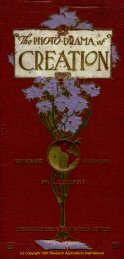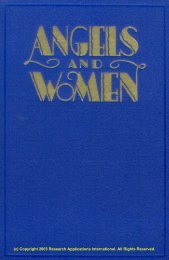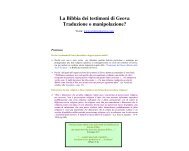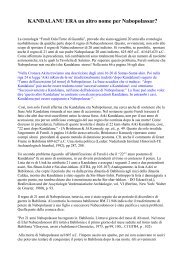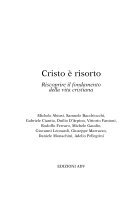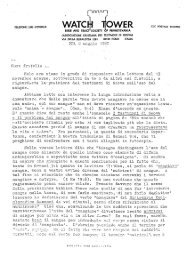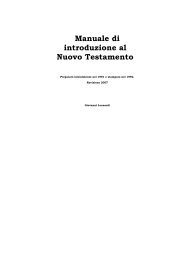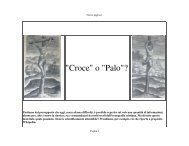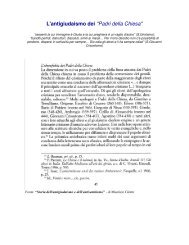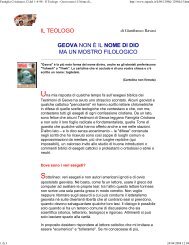CRONOLOGIA PERSIANA E DURATA DELL'ESILIO DEI GIUDEI
CRONOLOGIA PERSIANA E DURATA DELL'ESILIO DEI GIUDEI
CRONOLOGIA PERSIANA E DURATA DELL'ESILIO DEI GIUDEI
You also want an ePaper? Increase the reach of your titles
YUMPU automatically turns print PDFs into web optimized ePapers that Google loves.
dell'opera di Giuseppe. Egli inizia citando il quadro distorto dei regni Neobabilonesi reso da<br />
Giuseppe in Antichità X,xi, 1-2:<br />
"Nabopolassar 29 anni, Nabucodonosor 43 anni, Amel-Marduk 18 anni, Neriglissar 40<br />
anni" (p.69).<br />
Furuli ricava tale quadro da un'antiquata traduzione di William Whiston del 1737, la quale<br />
si basava su un testo che non è più accettato come il miglior testimone testuale. Se avesse<br />
consultato una moderna traduzione delle Antichità di Giuseppe egli avrebbe scoperto che<br />
almeno a Nabopolassar, sono attribuiti 21- non 29- anni (vedere, per esempio, la traduzione di<br />
Ralph Marcus in Loeb Classical Library.)<br />
Furuli crede che Giuseppe menzioni un numero errato altrove. Seguendo sempre l'obsoleta<br />
traduzione di WHiston, egli afferma nella nota a pié pagina n° 90 a pagina 69:<br />
“In "Contro Apione", sezione 17 [errore di 1,19], a Nabopolassar sono attribuiti 29 anni,<br />
ma si tratta di una citazione di Beroso. Giuseppe non menziona Nabopolassar e la<br />
durata del suo regno altrove “.<br />
Questa affermazione è altrettanto errata. Contro Apione 1,19, così come Antichità X,xi,1 assegna<br />
a Nabopolassar 21 anni secondo tutte le moderni edizioni di Contro Apione. *<br />
-------------------------------------------------------------------------------------------------------<br />
* Excursus: La migliore edizione testuale di Contro Apione di Giuseppe è quella di Benedictus Niese in<br />
Flavii Iosephi Opera, Vol. V (Berlin: Weidmann, 1889), Samuel Adrianus Naber in Flavii Iosephi Opera Omnia,<br />
Vol. VI (Leipzig: B. G. Teubner, 1896), H. St. J. Thackeray in Josephus (= Vol. 38:1 in the Loeb Classical Library,<br />
London: William Heinemann, and New York: G. P. Putnamn's Sons, 1926), and Théodore Reinach & Léon Blum,<br />
Flavius Josèphe Contre Apion (Paris: Société d'Èdition "Les Belles Lettres," 1930). William Whiston's translation<br />
was based on manuscripts that go back to one from the 12th century preserved in Florenz, Codex Laurentianus plut.<br />
lxix 22, usually referred to as L. Although this is the oldest preserved Greek manuscript of Against Apion, the best<br />
textual witness of Josephus' excerpts from Berossus in I,19 is Eusebius' quotations from Josephus' Against Apion in<br />
his Prepa ration for the Gospel, Book IX, Chapter XL, and also in the Armenian version of his Chronicle,<br />
24,29 and 25,5. Both works give Nabopolassa r 21 years. This figure is further supported by the Latin<br />
translation ("Lat.") of Against Apion made in the 6th century. (C. Boysen, Flavii Iosephi Opera ex Versione Latina<br />
Antiqua VI:II [= Vol. XXXVII in the Vienna Corpus Scriptorum Ecclesiasticorum Latinorum], 1898, p. 30. See also<br />
the comments on the textual witnesses by Alfred von Gutschmid in his "Vorlesungen über Josephus' Bücher,"<br />
published in Kleine Schriften [ed. by Franz Rühl], Band 4, Leipzig, 1893, pp. 500, 501). Josephus' Antiquities<br />
X,xi,1 clearly gives Nabopolassar a reign of 21 years. The figure 29 given in Codex Laurentianus (L) from the 12th<br />
century (on which all later manuscripts are based) is, therefore, demonstrably a late distortion that is corrected in all<br />
modern textual editions of Against Apion and Antiquities. (See also the comments by Thackeray, op. cit., pp. xviii, xix.)<br />
----------------------------------------------------------------------------------------------------<br />
Alla fine della pagina 69, Furuli cita due sezioni ampiamente distanti tra loro di Contro<br />
Apione. La prima tratta da Contro Apione 1,19 (pp.131, 132), nella quale si dice che<br />
Giuseppe affermi, secondo Beroso:<br />
“Nabopolassar inviò suo figlio Nabucodonosor con un grande esercito in Egitto e nel nostro<br />
paese, avendo avuto notizia che questi popoli si erano ribellati. E quando li ebbe sconfitti,<br />
bruciò il tempio di Gerusalemme, prelevò e deportò il nostro intero popolo a Babilonia,<br />
cosicché la città giacque desolata per settant'anni, fino al tempo di Ciro, re di Persia.”<br />
La cosa notevole riguardo a quest'affermazione è che egli pone l'incendio del Tempio nel regno<br />
di Nabopolassar. Ma esso in effetti avvenne 18 anni più tardi durante il 18° anno di suo figlio e<br />
33



